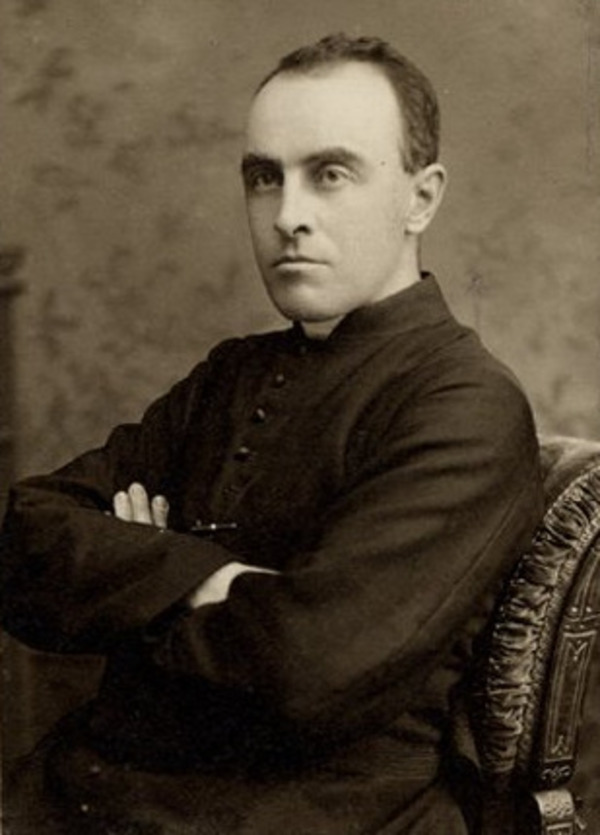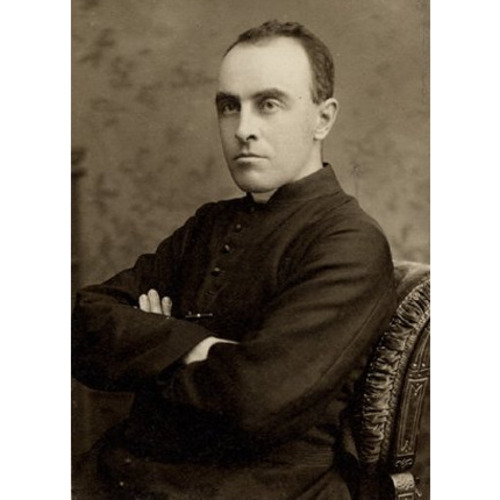As part of the funding agreement between the Dictionary of Canadian Biography and the Canadian Museum of History, we invite readers to take part in a short survey.

Source: Link
LAFLAMME, JOSEPH-CLOVIS-KEMNER, Roman Catholic priest, educator, scientist, and writer; b. 19 Sept. 1849 in Saint-Anselme, Lower Canada, son of David Kemner, dit Laflamme, a farmer, and Josephte Jamme; d. 6 July 1910 at Quebec.
Joseph-Clovis-Kemner Laflamme grew up in Saint-Anselme and in the nearby village of Buckland, whose curé, Pierre-Célestin Audet, took him under his wing and taught him the rudiments of Latin. In September 1862 he was admitted to the Petit Séminaire de Québec, where he was noted for doing well in music and science. Awarded the baccalauréat ès arts in 1868, he immediately entered the Grand Séminaire. After obtaining a licentiate in theology – the doctorate would follow in 1873 – he was ordained priest on 6 Oct. 1872.
Impressed by his intelligence, the authorities at the seminary had won his loyalty and had steered him into teaching science. In 1870 he was asked to replace Abbé Louis-Ovide Brunet* as instructor in natural history at the Petit Séminaire. He was also invited to take the science courses offered by Abbé Thomas-Étienne Hamel and François-Alexandre-Hubert La Rue* at the faculty of arts in the Université Laval. In 1874 he accompanied Hamel, who had become superior of the seminary and rector of the university in 1871, to a meeting of the American Association for the Advancement of Science in Hartford, Conn. Satisfied with his progress, Hamel handed the teaching of physics over to him in 1875. He was appointed to the chair of mineralogy and geology in the faculty of arts that year. To complete his scientific training the seminary sent him to Harvard University in Cambridge, Mass., for a course in theoretical and practical aspects of geology in 1877.
Laflamme is known primarily as a teacher. He taught physics at the seminary and the university until 1893, botany until 1900, and geology and mineralogy until just before he died. He was careful to keep abreast of developments in the sciences, and he enhanced his classes with demonstrations and experiments made possible by the physics laboratory and the collections of specimens, which were also in his charge at the university. In 1881 he published in Quebec Éléments de minéralogie et de géologie, a textbook for classical colleges which was reprinted three times during his life and again in 1919. A prolific writer, he put his name to a number of short, popularizing articles in L’Abeille, the seminary’s periodical, as well as in the press of the day.
In 1880 Laflamme had a good opportunity to expound his views on education in the sciences. The first conference of classical colleges affiliated with the Université Laval was held at Quebec that year and almost simultaneously a national convention of French Canadians, called by the Société Saint-Jean-Baptiste, met there. As a member of the committees studying the teaching of science both inside and outside the classical colleges, Laflamme proposed innovative reforms, such as broadening science instruction in the baccalauréat curriculum and adding it to all levels of the course of study, instead of restricting it to the last two years of the classical program (Philosophy). He further urged that state-controlled technical schools be created in which “people would be trained for diverse careers in industry and science” and for civil engineering. He also advocated that the state offer scholarships to students wishing to continue their education abroad and that science courses be included in the primary school curriculum. Laflamme was ahead of his time: a number of these reforms were introduced in Quebec only after 1920, and then under pressure from Adrien Pouliot* and Brother Marie-Victorin [Conrad Kirouac*].
At the seminary and the university, Laflamme’s responsibilities kept growing. Director of the minor seminary from 1881 to 1883 and dean of the faculty of arts from 1891 to 1909, he was twice superior of the seminary and rector of the university, from 1893 to 1899 and 1908 to 1909. Since the quarrel with Montreal over the universities [see Ignace Bourget*; Elzéar-Alexandre Taschereau*] had died down, his first term as rector was marked only by repercussions from a dispute over a provincial statute of 1890 that allowed people with a baccalauréat unconditional admission to study for the legal, notarial, and medical professions. There was strong and continuing opposition from professional bodies and a portion of the public to this legislation. His second term, though cut short by illness, enabled him none the less to support a campaign that would see a school of forestry established at the Université Laval in 1910.
Laflamme was well known beyond the confines of the seminary and university as a result of the lectures he gave before the Société Médicale de Québec, the Institut Canadien in Quebec, and the Literary and Historical Society of Quebec. A brilliant speaker and able popularizer, he acquainted the public with new inventions such as the magic lantern, the phonograph, electric lighting, the telephone, and X-rays. As much from personal inclination as from the need to represent the Université Laval, he travelled a great deal and was active in scientific societies. In 1881 he visited the exposition on electricity in Paris. He participated in a meeting of the British Association for the Advancement of Science at Montreal in 1884, and in international geological conferences in 1891 in Washington and in 1897 in St Petersburg, Russia, where he represented Canada. He also played a leading role during an international conference on American studies at Quebec in September 1906. President of the Royal Society of Canada in 1891, he was a member of the Société Géologique de France, the Société Française de Physique, the Société Scientifique de Bruxelles, and the Geological Society of America. In 1893 he was named apostolic protonotary by Rome, and in 1898 he was made a chevalier of the Legion of Honour.
Laflamme had taken part in the founding of the Royal Society of Canada in 1882 [see Sir John William Dawson*]. At that time he established closer contacts with scientists from across Canada, and in particular with those from the Geological Survey of Canada. In the summer of 1883 Alfred Richard Cecil Selwyn, its director, asked him to study the Saguenay and Lac Saint-Jean region for the survey. The collaboration continued in the following years, enabling Laflamme to explore the north shore of the St Lawrence from the Saint-Maurice to Anticosti Island, which he visited in 1901. His observations on the geology and physical geography of these regions, which were published in the reports of the Geological Survey and the transactions of the Royal Society, form the core of his scientific achievement. They reveal an observer attentive to the forces that had shaped the Laurentian landscape, who chose to work within the framework laid down by Sir William Edmond Logan* and the geologists of the survey. A number of Laflamme’s studies deal with practical aspects of the science; of particular interest are those on rockfalls or landslides in the province of Quebec, the gold-bearing deposits in the Beauce, and the natural gas in the Louiseville region. Some of these studies had been undertaken at the request of the Quebec government.
French Canada’s first geologist, Laflamme used his abilities as an educator and popularizer to make his community more aware of the scientific and technological progress of the time and prepared the groundwork for the reforms in education that Quebec would experience in the 20th century.
[Most of the documentation on Joseph-Clovis-Kemner Laflamme and his work can be found in Irénée Trottier, “Bio-bibliographie de Joseph-Clovis-K. Laflamme” (travail présenté pour le cours de bibliothéconomie, univ. Laval, Québec, 1961). r.d.]
AC, Québec, État civil, Catholiques, Notre-Dame de Québec, 9 juill. 1910. ANQ-Q, CE6-3, 19 sept. 1849. AUL, P109. René Bureau, “Monseigneur Clovis Laflamme et la météorologie,” “Monseigneur Joseph-Clovis-K. Laflamme, géologue,” and “La physique et l’électricité à l’université Laval au temps de Monseigneur J.-C.-K. Laflamme,” Le Naturaliste canadien (Québec), 79 (1952): 276–83; 77 (1950): 185–221; and 79: 330–45. H.-J.-J.-B. Chouinard, Fête nationale des Canadiens français célébrée à Québec en 1880: histoire, discours, rapport . . . (4v., Québec, 1881–1903). Raymond Duchesne, “Science et société coloniale: les naturalistes du Canada français et leurs correspondants scientifiques (1860–1900),” HSTC Bull. (Thornhill, Ont., and Ottawa), 5 (1981): 99–139. Yves Gingras, “La réception des rayons X au Québec: radiographie des pratiques scientifiques,” Sciences & médecine au Québec: perspectives sociohistoriques, sous la direction de Marcel Fournier et al. (Québec, 1987), 69–86. Arthur Maheux, “Savants du Canada français: Monseigneur Joseph-Clovis K. Laflamme, 1849–1910,” Le Naturaliste canadien, 90 (1963): 51–87, 157–76, 233–68, 275–309; 91 (1964): 116–25, 133–47. Zaslow, Reading the rocks.
Cite This Article
Raymond Duchesne, “LAFLAMME, JOSEPH-CLOVIS-KEMNER,” in Dictionary of Canadian Biography, vol. 13, University of Toronto/Université Laval, 2003–, accessed March 29, 2025, https://www.biographi.ca/en/bio/laflamme_joseph_clovis_kemner_13E.html.
The citation above shows the format for footnotes and endnotes according to the Chicago manual of style (16th edition). Information to be used in other citation formats:
| Permalink: | https://www.biographi.ca/en/bio/laflamme_joseph_clovis_kemner_13E.html |
| Author of Article: | Raymond Duchesne |
| Title of Article: | LAFLAMME, JOSEPH-CLOVIS-KEMNER |
| Publication Name: | Dictionary of Canadian Biography, vol. 13 |
| Publisher: | University of Toronto/Université Laval |
| Year of revision: | 1994 |
| Access Date: | March 29, 2025 |



